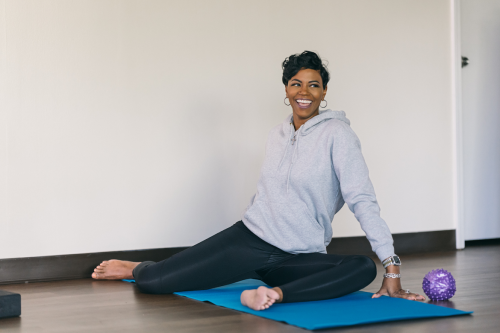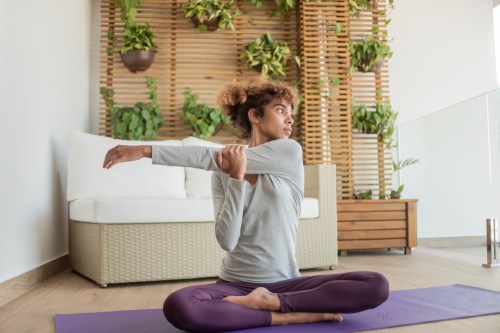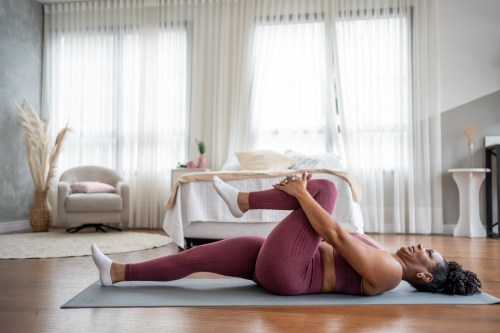Maintaining Mobility As You Age Is Key to Longevity—But It’s Use It Or Lose It
Discover how to maintain mobility as you age, as well as tips for getting the most out of your mobility training.

At this point, you likely know just how important mobility training is to how well you move—even if you don’t reach for the foam roller as often as you should. Mobility, or your ability to move your joints through their full range of motion, involves more than just flexibility of soft tissue. It also includes your muscles and connective tissue and your nervous system’s ability to move the joints, and all of that affects longevity.
Experts in This Article
“Joints need to be able to get into positions in order to absorb and adapt to stress efficiently,” explains Kevin Carr, certified functional strength coach and co-founder of Movement As Medicine. If your hips don’t move well, when you go to pick something up from the ground, you could end up moving through your lower back or ankles in a way that puts unnecessary stress on those areas, he explains.
But it’s not just preventing you from blowing out your back: Mobility training improves your work in the gym, too. Just consider the depth of your squat and your comfort loading that movement—improving your ankle mobility can help you go deeper more comfortably.
So, you know the benefits of mobility training, you set a goal to stretch before all (OK, most) workouts, but how long should it take for you to see—and more importantly, feel—results? And how can you best maintain your mobility as you age for longevity?
First, how long does it take to notice results from mobility training?
There are many different reasons you could be dealing with limited mobility, including joint restriction, nerve tightness, and more. That context matters, says Ryan Chow, DPT, founder of Reload, a physical therapy and fitness practice.
“Depending on what the goal of improving mobility is, and how the person is going to use it, it may be in a matter of minutes to many months to make change,” says Chow.
That said, if you are moderately active and uninjured, you should begin to notice a difference in your mobility within 3 to 4 weeks with consistent mobility sessions (usually 2 to 3 times a week), says Carr, who likens it to how long it would take you to notice a strength gain. “As little as 2 minutes a day per joint, on most days (4 to 7 days a week),” should yield similar results, adds Chow.
That expectation—and your ability to maintain mobility—will shift as you age.
“As you get older, tissue change becomes more difficult just as adding muscle does,” says Carr. “Your tissue quality and structure changes and becomes more fibrous in nature, so sometimes those changes take longer to happen.”
Progress also tends to be slower if you’re dealing with an injury that has impacted your movement patterns, such as a rotator cuff injury in the shoulder. That’s partially because injuries can create a lot of “reactive tension,” where other muscles around the injury tend to tense up to protect the joint, explains Carr.
“Older or injured people may have to work harder or longer at it to improve, but there is almost always potential to improve,” says Chow.
Tips to get the most out of your mobility training
Think about short vs. long-term results
There are both acute and chronic adaptations to mobility work, explains Carr. “If you foam roll and stretch for a few minutes, you’re going to get up and immediately feel like you can move a little better, but that’s the nervous system’s adaptations,” he says. “That’ll happen instantly, but it’s temporary in that if you go back to sitting at your desk, and you’ll [start to] feel stiff again.”
However, if you’re foam rolling, actively stretching, and even more importantly, strength training through a full range of motion, you’ll start to experience more tissue extensibility and joint capsules that extend and move better, adds Carr.
Think about making deposits in your mobility bank account daily, he says. Whether that’s foam rolling while binging your favorite TV show, not skipping the stretch at the end of a fitness class, or thinking about pushing or pulling over head as much as you safely can during your next workout—all of that adds up to greater mobility wealth over time.
It doesn’t require much time
All you really need is 5 to 10 minutes of dedicated mobility work, ideally before a workout, says Carr.
Doing mobility work, such as active stretching, directly before exercise not only primes the muscles for whatever stress lies ahead, but it also helps you ensure you actually get it done, he says. How many times have you rushed out of class after a workout but before the cooldown? But know this: “Big picture, just make sure you’re getting it in because something is better than nothing,” says Carr.
Your favorite workout plays a role
Whether you’re a runner, cyclist, weight lifter, or rower, your activity of choice will impact your mobility, says Carr. But it’s more than just your workouts that contribute to added tension, it’s whatever repetitive movements, or inactivity, your lifestyle requires.
“Your most frequent daily activity impacts your mobility—whether it’s 8 hours in a chair or 2 hours on the ice [playing hockey, as do some of Carr’s clients] a day—that’s going to affect how your tissue is formed and how your joints move.”
Make a plan for tracking progress
“Measure against a standard,” suggests Chow. “If you’re doing a toe touch, measure the distance your hands are from the floor.” Then continue to measure the distance as you move through your mobility sessions.
Another way to keep an eye on improvements is through strength training, says Carr. You may find that you’re now able to hinge while maintaining a flat back, or that you’re able to squat deeper before your heels lift, for example. But “the big missing piece with mobility is intent,” he says.
Ask yourself: What’s my reason for working on mobility? Is it being able to perform a chin up, because you can’t extend your arms overhead? Is it to comfortably bend down to pick up your dog’s ball for long games of fetch? From there, it may be easier to dial into your progress, and once you begin to notice those improvements, you’re more likely to stick with it.
Strength training matters—a lot
Mobility isn’t just about “having the range of motion but also having the strength to be able to move through that range of motion and use it,” says Carr.
Passive flexibility alone isn’t very valuable, as it’s not functional. Think about how often you need to be able to get into a comfortable straddle split in life versus how often you need to be able to have the flexibility, mobility, and strength to lift something heavy overhead (hi, luggage).
“Training with active mobility work but also strength training is vital,” he adds.
Use it, or risk losing it
Once you’ve reached a given mobility goal, don’t sleep on the necessary work to maintain that progress. “The body is going to adapt to whatever stresses you give it or don’t give it,” says Carr. “If you don’t put your arm overhead very often, eventually you’re not going to be able to put your arm overhead. Continually check in with your joints, and maintain your joints because you can’t maintain your mobility if you don’t use your mobility.”
Simply put, “if you don’t use it, you lose it,” says Chow. “Using the most challenging end ranges of motion once a week will ensure you never lose it.”
Create a 5- or 10-minute mobility routine and have that be the first thing that you do to ensure you’ll consistently do it, suggests Carr.
“I tell people in their 20s and 30s, mobility gets more important as you get older, not less important,” says Carr. “Make sure you’re strength training through a full range of motion all the time. I think that’s ultimately how you maintain it is using it so that you essentially hit the save button.”
Sign Up for Our Daily Newsletter
Get all the latest in wellness, trends, food, fitness, beauty, and more delivered right to your inbox.
Got it, you've been added to our email list.










